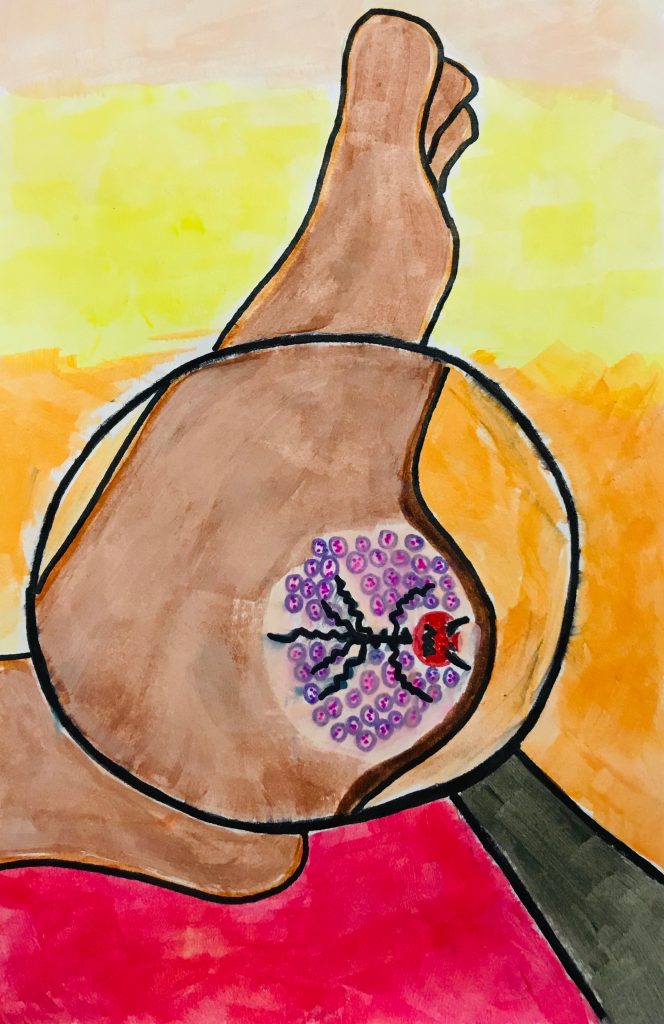Planta Wart
Plantar wart is a skin infection causes by the human papillomavirus (HPV) type one, two
and four, which is a DNA virus. Plantar wart has two types which are solitary wart and
mosaic wart. Solitary wart is a single wart and often increases in size and may eventually
multiply and forming additional satellite warts. Mosaic wart is a cluster wart and often more
difficult to treat than solitary wart.
Plantar wart is asymptomatic and self-resolving by our immune responses, but the
viruses can overcome the host immune defenses and invading in keratinocytes, cell of
epidermis. Once the tissue become infected by the wart viruses, it penetrates deep down to
dermis skin layer. The wart becomes very difficult to get rid of because of the treatment cannot
goes down deep enough to affect the whole viruses, therefore, the infection is more likely
reoccurring. Plantar wart usually occurs on foot, plantar, the name suggested, especially right at
the weight bare areas, which cause plantar wart to grow inward and can be painful when walk or
put pressure on it.
The signs of the plantar wart infection, start with a small bump with a rough
surface. The blood vessels, capillaries, clothed and look like dark spots in the center of the
bumpy skin. The infected area can be itchy and sensitive.
Plantar wart usually transmits by skin to skin contact, but not everyone will get
infection from the virus because of the body immune system of individual act different way.
Some people can get the infection from just walking bare foot on the public swimming pool or
from soaking feet in the tub at the foot spa service.
Plantar wart can be treated by the over-the-counter drug at the drug’s store, such as
peeling medication like liquid salicylic acid that will peel the outer layers of the skin off. Freezing
medication like liquid nitrogen will freeze the wart viruses and fall off. Some dermatologist
suggests combination of peeling and freezing medication for stronger effect. The last treatment
is a home remedy which using an apple cider vinegar and a duct tape. Cleaning the area with
an apple cider vinegar, let it dry, and then cover it up with a duct tape.
After being medicated, the area may become sore or painful for a couple of days
because of the damaging of a healthy tissue around the wart. If the infection reoccurs or
becomes persisted, next step is to consult dermatologists. They will describe a stronger
medication. They also have more options such as carbon dioxide laser, or perform a minor
surgical remove that can be done at their office, but not strongly recommended because it can
also cause the spreading of the viruses.
Plantar wart, a virus skin infection can be prevented by a simply hand hygiene after
having a contact with infectious objects or close contact with infected person and animal. Do not
pick or scratch wart area. Avoid walking on bare foot in the public pool and looker areas. Do not
share the personal items with other event with family member if you have infection going on.
Citation:
D.A. Palermo-dilts, T.R. Broker, and L.T. Chow. (1990). Human papillomavirus type 1 produces
redundant as well as polycistronic mRNAs in plantar warts, Journal of Virology, 64(6),
3144-3149. Retrieved from https://www.ncbi.nlm.nih.gov/pmc/articles/PMC249512/
J.A. Westrich, C.J. Warren, and D. Peyon. (2017). Evasion of Host Immune Defenses by
Human Papillomavirus, Virus Res, 231, 21-33. Retrieved from
https://www.ncbi.nlm.nih.gov/pmc/articles/PMC5325784/
R. Gupta and S. Gupta. (2015). Topical Adapalene in the Treatment of Plantar Warts;
Randomized Comparative Open Trial in Comparison with Cryo-Therapy, Indian Journal
of Dermatology, 60(1), 120. Retrieved from
https://www.ncbi.nlm.nih.gov/pmc/articles/PMC4318023/

